Home Office workforce diversity statistics 2020 to 2021
Published 16 June 2022
This is not the latest release. (View latest release).
Home Office responsible statistician: Amy Baxter
Press enquires: pressoffice@homeoffice.gov.uk
Telephone: 020 7035 3535
Public enquiries: DIVERSITYTEAM-INBOX@homeoffice.gov.uk
This publication forms part of the Home Office’s response to Recommendation 28 of the Windrush Lessons Learned Review, which states:
“The department should publish comprehensive annual workforce data, so it can monitor progress.”
The statistics included in this release go beyond the recommendation and cover broader identity categories, examining representation by grade where possible, and by different areas within the Home Office.
The findings presented in this report are based on data extracted from the Department’s central human resources reporting system (known as ‘Metis’), as at 31st March 2021. The majority of the data has been self-reported by staff. Self-reporting is voluntary, and therefore the findings relate to a subset of the Home Office workforce.
The statistics show that despite efforts to improve, there is still underrepresentation in both the Senior Civil Service (SCS) and in the pipeline to SCS for Black, Asian and minority ethnic staff. The data shows too, that staff with disabilities are underrepresented throughout the workforce.
There is much more work to be done to ensure that the Home Office is representative of the communities we serve. The forthcoming revised Home Office diversity and inclusion strategy will set out our plans for improving accountability, inclusion and representation within the organisation.
1. Introduction
The Home Office employs approximately 35,000 people in a wide range of roles across the UK and overseas. These people work in one of four functions:
- Borders Immigration and Citizenship System (BICS), this encompasses staff in UK Visas and Immigration, Border Force, Immigration Enforcement and HM Passport Office
- National Security - staff in this area work to counter threats from terrorism
- Public Safety - this includes staff who support work on policing and fire and rescue services
- Enablers - this includes staff that support other functions through a variety of means, including analysis, HR, and IT
As shown in Figure 1, the majority of staff (81%) are employed in BICS. This includes a large number of operational staff such as Border Force officers and UKVI caseworkers. In contrast, Public Safety (4% of the total workforce), and National Security (3% of the total) are largely made up of policy specialists. As a result of the dominance of BICS staff in the data, many Home Office level statistics are heavily influenced by the representation in BICS. To enable a clearer picture of the diversity of the Home Office workforce, the representation rates have been calculated at both the departmental and function levels where possible.
In the following sections, the representation of Home Office staff have been reported by sexual orientation, ethnicity, gender and people with disabilities. These are compared with the targets set out in the Department’s existing diversity and inclusion strategy Inclusive by Instinct, and then split out by the business functions. As part of the work the Department is doing in response to the Windrush Lessons Learned Review, the Home Office has reviewed its diversity and inclusion strategy, to include more success measures for SCS and all-people representation targets.
Figure 1: Distribution of staff in the Home Office, by function
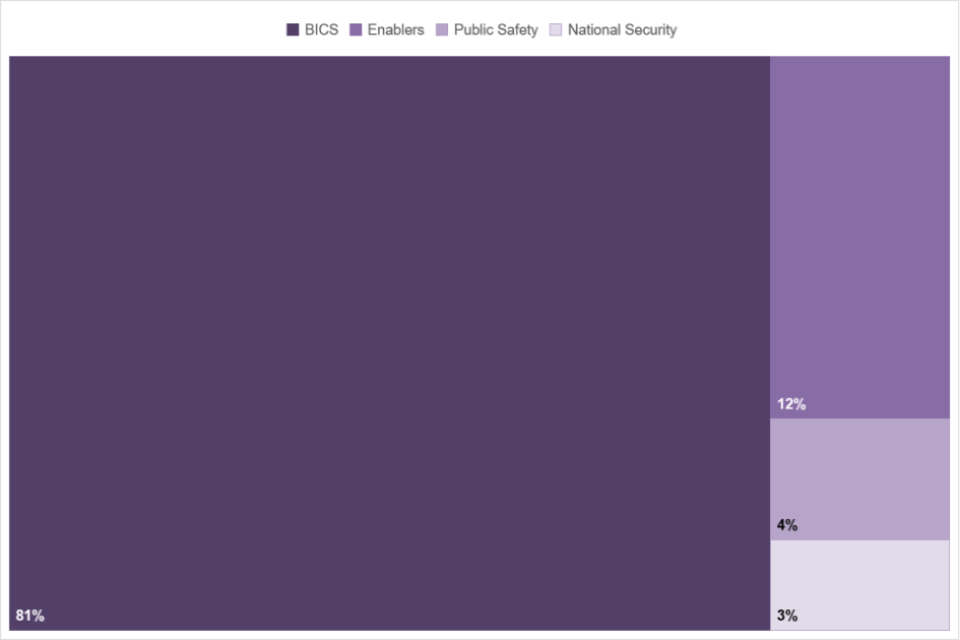
Source: Home Office workforce diversity statistics 2020 to 2021: data tables
Home Office grades are summarised below. They range in ascending order from the most junior staff at Administrative Assistant and Administrative Officer, through to Senior Civil Servants who hold greatest seniority. Home Office grades, from least to most senior:
- Administrative Assistant or Administrative Officer (AA or AO)
- Executive Officer (EO)
- Higher Executive Officer or Senior Executive Officer (HEO or SEO)
- Grade 7 (G7)
- Grade 6 (G6)
- Senior Civil Servant, SCS (SCS1, 2, 3 and 4)
2. Comparison to targets
The Home Office Inclusive by Instinct diversity and inclusion strategy was published in 2018. It sets out a series of representation targets for the Department to achieve by 2025. These are set out in Table 1.
The data provides a snapshot as at 31st March 2021. The data includes overseas and non-paid staff and the majority of the data has been self-reported by staff. Self-reporting is voluntary, and therefore does not provide a complete picture of the diversity of the Home Office workforce.
These overall targets were derived by setting them equal to either the UK economically active population or current Home Office representation, whichever was higher at the time of them being set. Since the original targets were produced the current UK working population representation rates for some groups have been refreshed, see Table 2.
When considering the representation rates listed for 2018, 2020 and 2021, particularly for SCS, the total population size in some of the cohorts may be relatively low. An increase or decrease of just a few individuals can have a noticeable impact on the percentages reported. It is expected that there will be some variation in the representation rates from year to year, with the overall trend being the important indicator of success.
Table 1: Progress against diversity targets
| Characteristic | Grade | Target | 2018 | 2020 | 2021 |
|---|---|---|---|---|---|
| Black, Asian and minority ethnic | |||||
| All Staff | 24% | 24% | 23% | 24% | |
| SCS | 12% | 6% | 7% | 7% | |
| Disability | |||||
| All Staff | 12% | 9% | 9% | 9% | |
| SCS | 5% | 3% | 8% | 7% | |
| Women | |||||
| All Staff | 52% | 52% | 52% | 52% | |
| SCS | 47% | 39% | 47% | 45% | |
| Lesbian, Gay and Bi* | |||||
| All Staff | 6% | 3% | 4% | 4% | |
| SCS | 6% | 5% | 5% | 5% |
* At the time of collecting this data, the Home Office’s human resources recording system only allowed staff to record themselves as either “Heterosexual / Straight” or “LGB”. See definitions for further detail.
The representation rate presented in Table 1 is the proportion of people who reported having a specific characteristic (e.g. Female) as a proportion of all people who answered the question for that characteristic (e.g. sum of all people identified as Male or Female).
Table 2 provides some context to the representation rates with estimates of the demographics of the UK working population:
Table 2: UK population diversity estimates
| Characteristic*** | Sub-division | Percent | Date* | Geography | Note | Source |
|---|---|---|---|---|---|---|
| Ethnicity | 2011 | England and Wales | People aged 16-64 | GOV.UK | ||
| White | 85.6% | |||||
| Asian | 8.1% | |||||
| Black | 3.4% | |||||
| Mixed | 1.8% | |||||
| Other | 1.1% | |||||
| Disability | Jan-Mar 2020 | Great Britain | Economically active people aged 16-64 | GOV.UK | ||
| Disabilities defined under Equality Act 2010 | 11.5% | |||||
| Women | 2011 | UK | People aged 16-74 | GOV.UK | ||
| All women aged 16-74 | 50.5% | |||||
| Sexual Orientation** | 2018 | UK | People aged 16-64 | GOV.UK | ||
| Lesbian, Gay or Bi | 2.7% |
* UK 2011 census is now 10 years old, where more up-to-date data has since been made available population estimates have been revised.
** The higher target for Lesbian, Gay and Bi people in Inclusive by Instinct was based on estimates created for the passage of civil partnership legislation. Since then, the ONS published in 2018 experimental data on Sexual Orientation in the UK which is used as the source for this table.
*** The Home Office employs people in all countries in the UK. Population estimates for ethnicity only refer to England and Wales. Disability population estimate refers only to Great Britain as the Equality Act 2010 does not apply to Northern Ireland.
Disability
Figure 2: Representation of people with disabilities, SCS staff
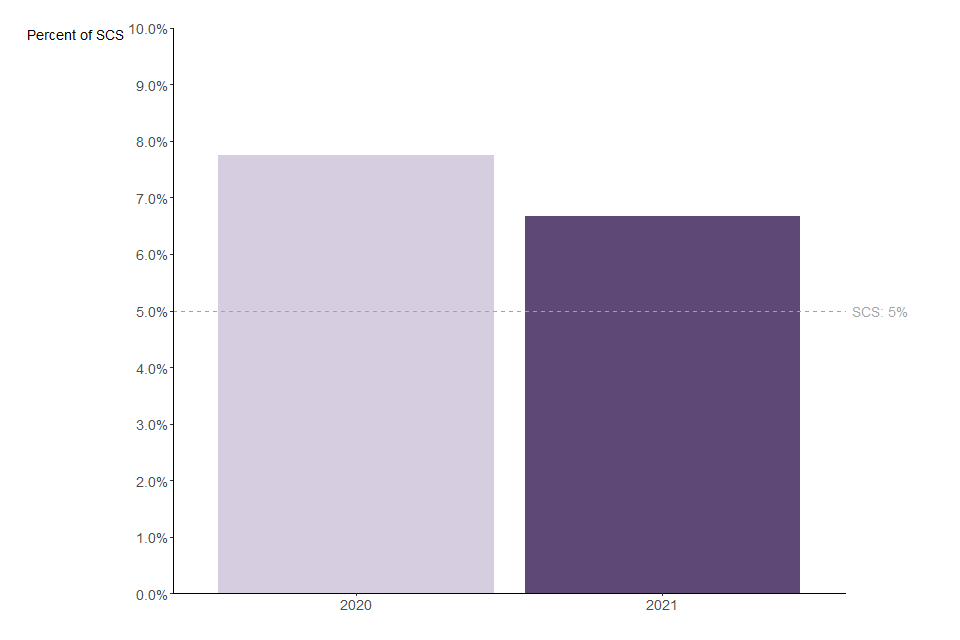
Representation of people with disabilities at SCS level has decreased by 1.0 percentage points, from 7.7% in 2020 to 6.7% in 2021. In March 2021 representation of people with disabilities remained above the target of 5%.
Figure 3: Representation of people with disabilities, all staff
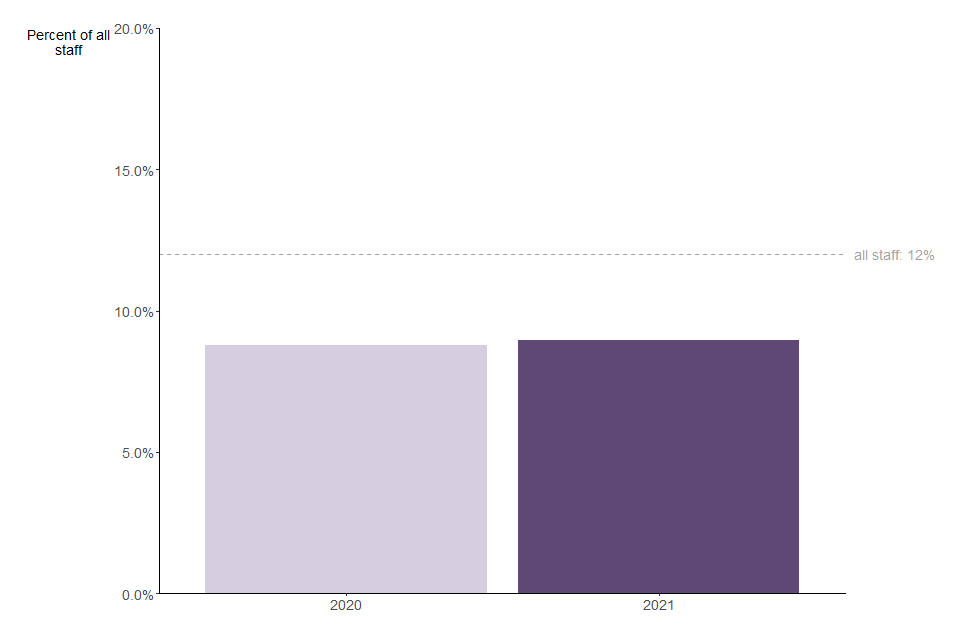
Representation of people with disabilities amongst all staff has remained below target. The Department is not currently representative of the UK working population.
Ethnicity
Figure 4: Representation of people from an ethnic minority background, SCS staff
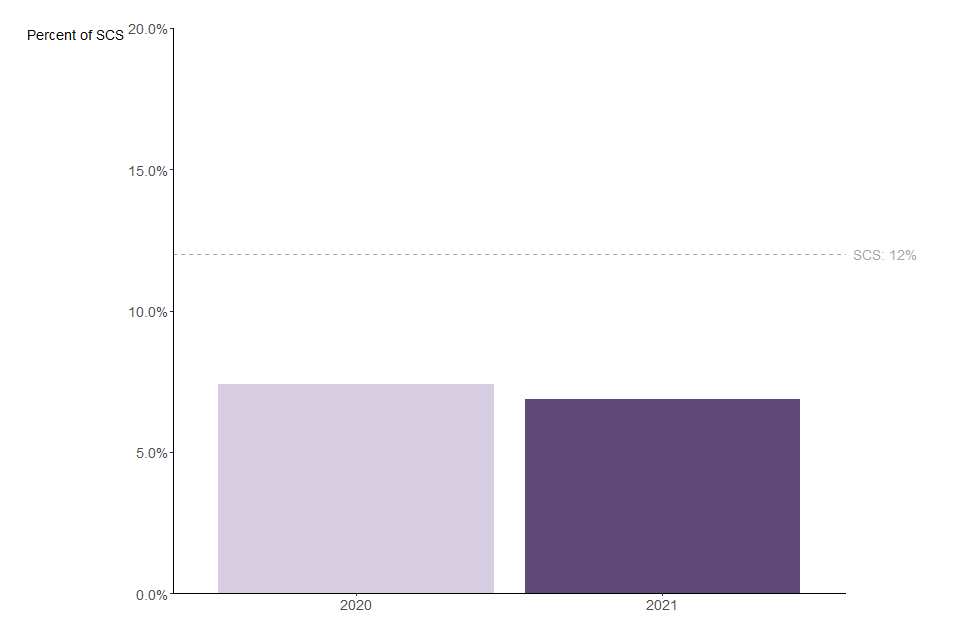
In the SCS, representation of Black, Asian and ethnic minority staff has decreased by 0.5 percentage points, from 7.4% in 2020 to 6.9% in 2021. In March 2021, it remained below the target of 12% set in 2018.
Figure 5: Representation of ethnic minority people, all staff

Representation of people from a Black, Asian or ethnic minority background has increased slightly since 2020 amongst all staff, from 23.3% in 2020 to 23.9% in 2021. This is slightly below the 24% target, but still above the England and Wales population estimate for people from a Black, Asian or ethnic minority background of 14%.
Sexual Orientation
Figure 6: Representation of lesbian, gay or bi people, SCS staff
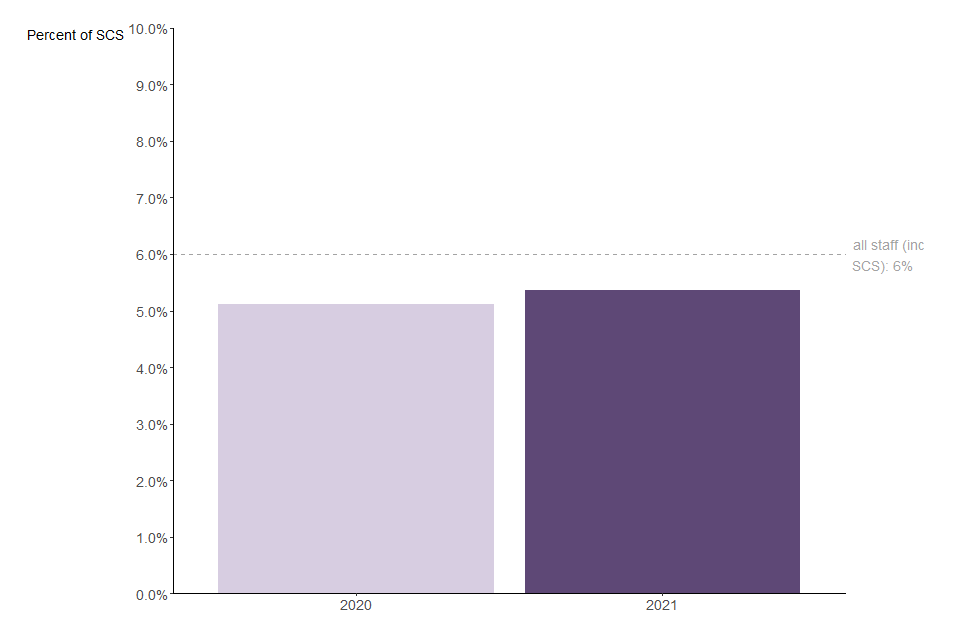
Representation of Lesbian, Gay and Bi (LGB) staff in the SCS has increased by 0.3 percentage points, from 5.1% in 2020 to 5.4% in 2021. In March 2021, it remained below the target of 6% set in 2018.
Figure 7: Representation of lesbian, gay or bi people, all staff
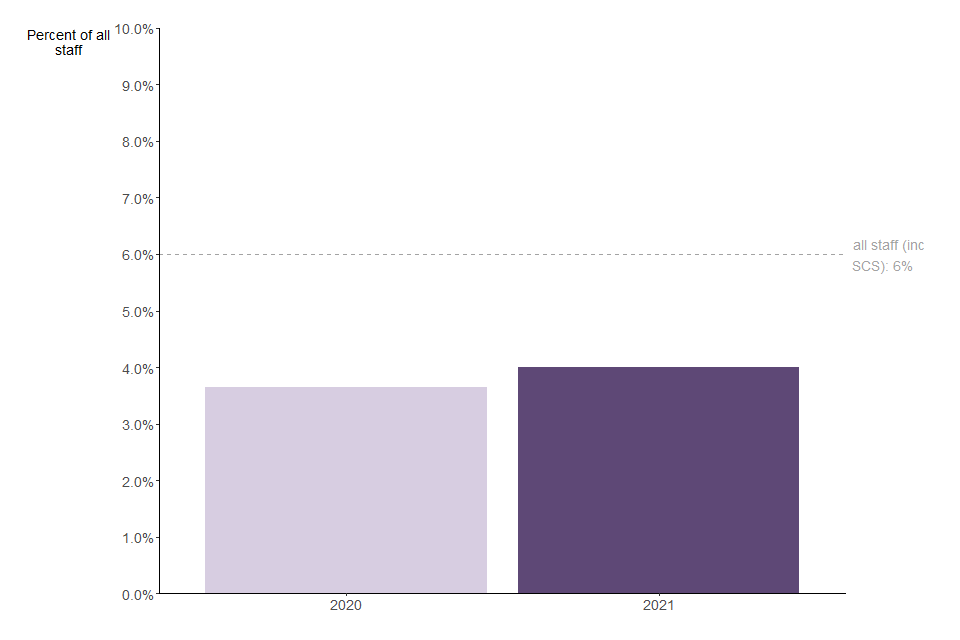
Representation of LGB staff has also increased by 0.3 percentage points amongst all staff, from 3.7% in 2020 to 4.0% 2021. This was below the target of 6% of all staff, set in 2018.
Women
Figure 8: Representation of women, SCS staff
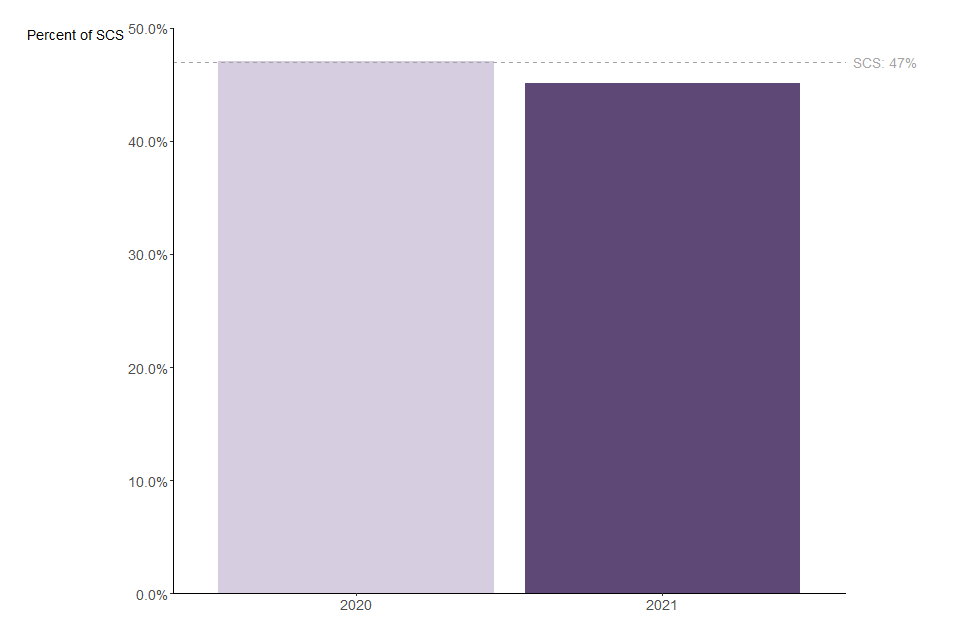
Representation of women in the SCS has decreased by 1.9 percentage points, from 47.0% in 2020 to 45.1% in 2021. The figures as at end of March 2021 show that the representation of women in the SCS was below the target of 47% set in 2018.
Figure 9: Representation of women, all staff
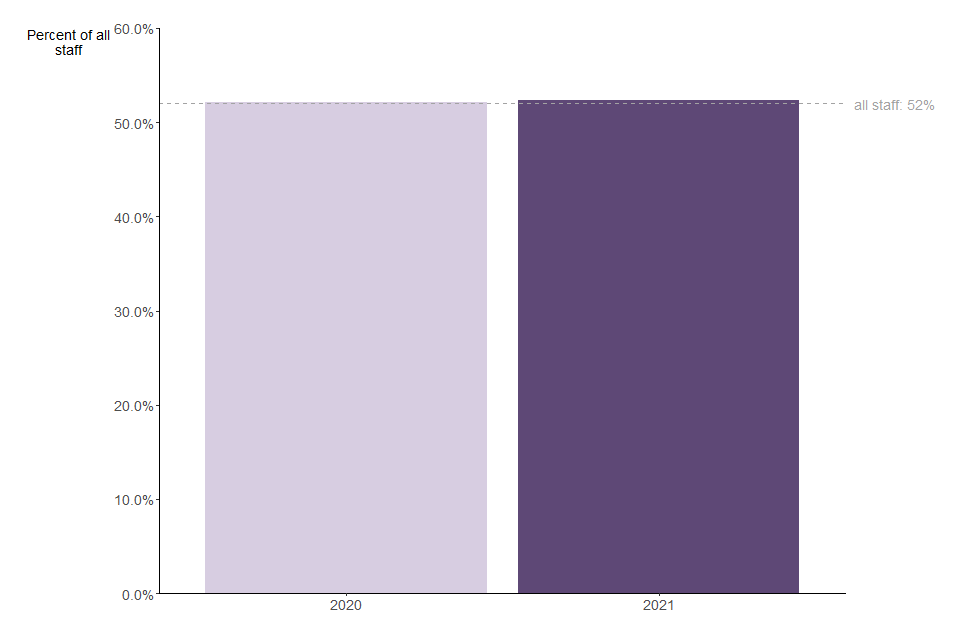
In March 2021, the Department met its target of 52% for representation of women for all staff. Representation of women was similar for March 2020.
3. Analysis of Protected Characteristics
In this section, representation of protected characteristics has been analysed in more detail. Representation has been broken down by grade and departmental function to provide more granular detail of representation in the Home Office.
Age
Figure 10: Proportion of staff by age and grade
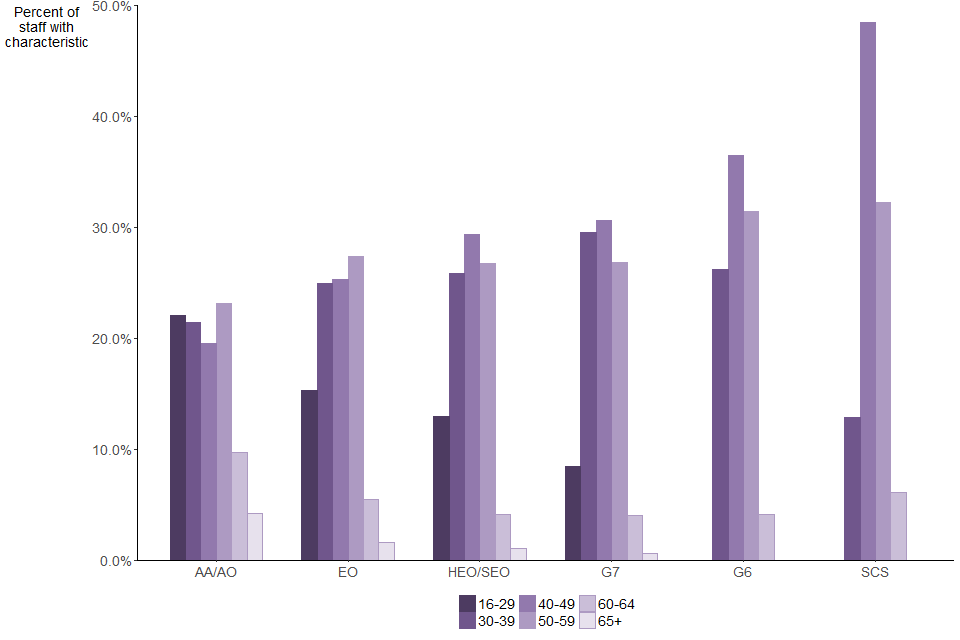
Source: Home Office workforce diversity statistics 2020 to 2021: data tables
Notes:
- Categories with fewer than 10 individuals have been removed.
The most represented age group at SCS was 40-to-49, with 48% of staff in this age group as at the end of March 2021.
In March 2021, for the National Security and Public Safety functions, the most represented age group was 30-to-39 year olds. For the National Security function, 37% of staff were aged 30-to-39, and 31% of Public Safety staff were within this age group. For the Enablers function, the most represented age groups were 40-to-49 year olds, (26%), and 50-to-59 year olds (26%). For the BICS function, the most represented age group was 50-to-59 year olds (27%).
In March 2021, there was a higher representation of 16-to-29 year olds at AA/AO grades than at other grades. The representation of 16-to-29 year olds, decreased from 22% at AA/AO grades, to 8.5% representation among Grade 7 staff, and 0% at SCS.
Disability
Figure 11: Proportion of staff with disabilities, by grade and business area
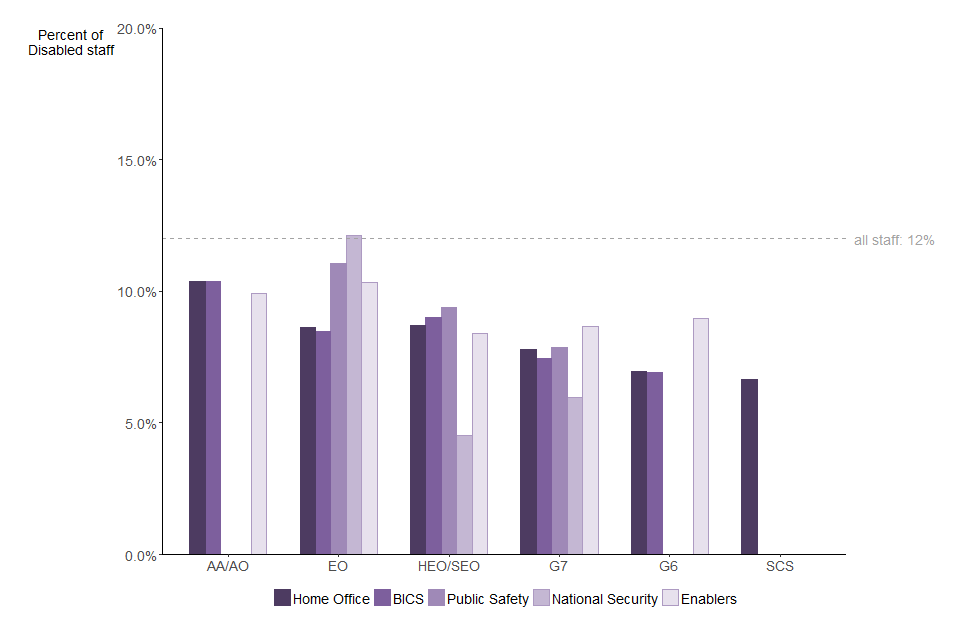
Source: Home Office workforce diversity statistics 2020 to 2021: data tables
Notes:
- Categories with fewer than 10 individuals have been removed.
The Department currently exceeds its representation target of 5% for people with disabilities in the SCS, with 6.7% of SCS staff reporting that they have a disability. The number of individuals with a disability at SCS in each function was too small to be reported by individual function.
Amongst all staff the Department currently does not meet its target for people with disabilities, with 9.0% of staff having a disability. The target for representation of people with a disability is 12%.
Representation of people with a disability tends to be negatively correlated to grade, with 10.4% representation at AA/AO grades, reducing to 6.7% at SCS level.
Ethnicity
Figure 12: Proportion of staff from an ethnic minority background, by grade and business area
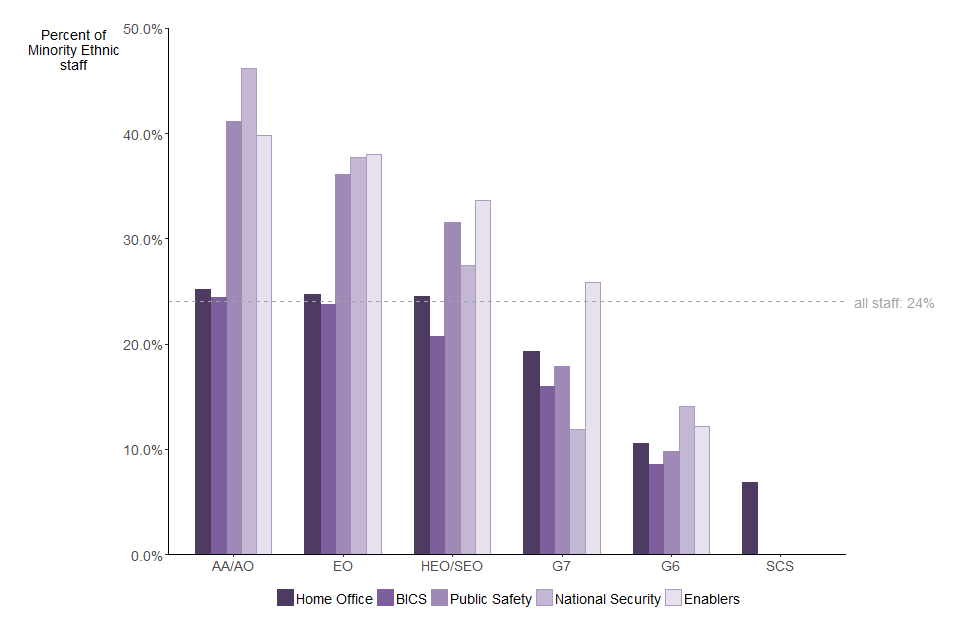
Source: Home Office workforce diversity statistics 2020 to 2021: data tables
Notes:
- Categories with fewer than 10 individuals have been removed.
The Department currently does not meet its target for representation of Black, Asian and ethnic minority people in the SCS. As at March 2021, around 6.9% of SCS staff were from a Black, Asian or ethnic minority background. The target set in 2018 is at least 12%. Individual functions had low representation, at SCS level, and are not reported to protect anonymity.
Amongst all staff, the Department currently meets its target for representation of staff from a Black, Asian or ethnic minority background, with 24% of staff (2018 target is 24%). Representation of staff from an ethnic minority background is negatively correlated to grade, as representation tends to be lower at higher grades.
Of the different functions, people from a Black, Asian or ethnic minority background had the largest representation in the Enablers function, with 31% for March 2021 across all staff, exceeding the target of 24%. The next highest representation was in the Public Safety function, with 26% for March 2021.
In March 2021, for AA/AO, EO, and HEO/SEO grades, the representation rates for staff with an ethnic minority background met or exceeded the target of 24% for each of these grades. This contrasts with more senior grades’ representation of 19% for Grade 7, and 11% for Grade 6.
Figure 13: Proportion of staff from an ethnic minority background, by ethnicity and grade

Source: Home Office workforce diversity statistics 2020 to 2021: data tables
Notes:
- Categories with fewer than 10 individuals have been removed.
Ethnicity is also broken down into a more detailed analysis at the whole department level, excluding White. White has not been included in Figure 13, because including it would allow the reader to deduce redacted values which have been removed to preserve anonymity.
All ethnicities, except for white, had fewer than 10 individuals at the SCS level, and so were unable to be reported to protect anonymity of Home Office staff.
People from an Asian or Asian British background had the largest representation, after White, in each of the functions. Enablers had the largest proportion of Asian or Asian British staff - 18% of all Enablers staff were from an Asian or Asian British background, as at March 2021.
Religion and Belief
Figure 14: Proportion of staff reporting religion and beliefs, by grade
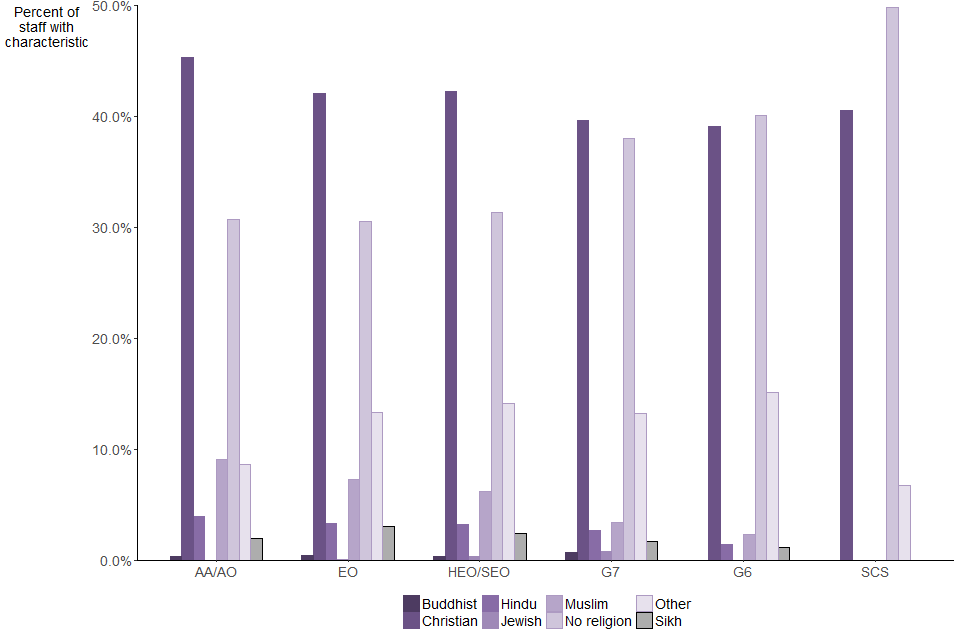
Source: Home Office workforce diversity statistics 2020 to 2021: data tables
Notes:
- Categories with fewer than 10 individuals have been removed.
Half of SCS staff reported ‘No religion’.
For AA/AO, EO, HEO/SEO grades and Grade 7 staff, the most frequently reported religion or belief was Christian. The most frequently reported religion for Grade 6 or SCS staff was No Religion.
The Christian and ‘No Religion’ groups were the most commonly reported across all grades. In all cases, the next most commonly reported were ‘Other religion or belief’ and Muslim.
Sexual Orientation
Figure 15: Proportion of lesbian, gay and bi staff, by grade and business area

Source: Home Office workforce diversity statistics 2020 to 2021: data tables
Notes:
- Categories with fewer than 10 individuals have been removed.
No function in the Department achieved the 6% target for Lesbian, Gay or Bi representation, in March 2020 or March 2021. In March 2021, National Security had achieved the highest LGB representation at 5.9%.
The Department currently does not meet its target for LGB staff in the SCS. As at March 2021, 5.4% of SCS staff are LGB, this compares to the target of at least 6%. The number of individuals in each function was too low to be reported individually. Representation of LGB staff has increased slightly for the SCS grades, with an increase of 0.2 percentage points across the Department overall.
Amongst all staff the Department currently does not meet its target for LGB staff, with 4.0% of staff against a target of 6%.
The functions with the largest representation of LGB staff are National Security at HEO/SEO grades (7.5%) and Public Safety at Grade 7 (7.1%). These are the only areas where the Home Office currently meets the target for representation of LGB staff.
Women
Figure 16: Proportion of female staff, by grade and business area
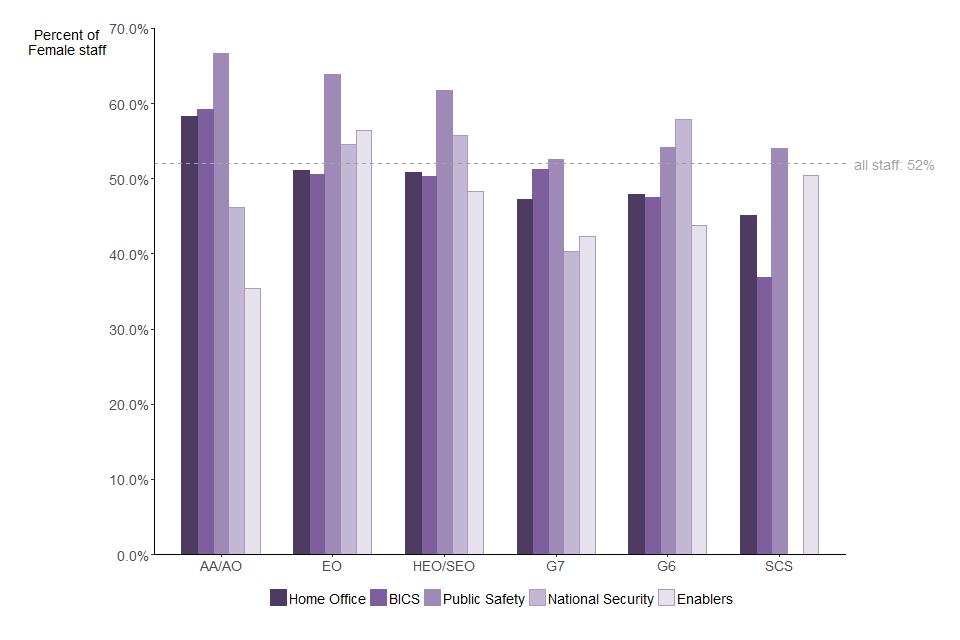
Source: Home Office workforce diversity statistics 2020 to 2021: data tables
Notes:
- Categories with fewer than 10 individuals have been removed.
The Department currently does not meet its target for representation of women in the SCS. As at March 2021, 45% of SCS staff were women, this compares to the target of at least 47%. Greatest representation is in the Public Safety function, where 54% of SCS staff were female. The Enablers function also exceeded the target in March 2021, whereby 50% of SCS staff were female. Other functions did not meet the target for representation of women at SCS. Female staff were least represented in the BICS function, where 37% of SCS staff were female in March 2021.
Amongst all staff the Department currently meets its target for women, with 52% of staff against a target of 52%. Representation of women is negatively correlated to grade, as representation tends to be higher at more junior grades.
Women had a larger representation at AA/AO grades, with 58% of staff across the Department. This exceeds the Department’s target. However, at grades EO (51%), HEO/SEO (51%), Grade 7 (47%) and Grade 6 (48%), representation was below the 52% target.
4. Data Sources
Data for this analysis was extracted from the Department’s Metis system, which is the central system for human resources reporting.
The data provides a snapshot as at 31st March 2021. The data includes overseas and non-paid staff and the majority of the data has been self-reported by staff. Self-reporting is voluntary, and therefore does not provide a complete picture of the diversity of the Home Office workforce, as some staff do choose to withhold information through the “Prefer Not To Say” response. Others may not have been surveyed, so no data are available for these individuals, this is particularly true of overseas staff for whom the Department only holds information regarding gender. There may also be individuals who misreport, either through accident or design. While this is considered unlikely to be widespread, where percentages are very low, a small number of individuals would have noticeable impacts on the results.
The Department continues to explore how to improve its declaration rates, for example by making improvements to the categories an individual can self-define as, as well as consistent messaging on why data is needed, what it is used for, reassurance on data security, how data is stored and anonymity protection.
SCS data
Data for SCS in the Department is extracted from the Metis system. This is different to the data used in the Civil Service Diversity and Inclusion Dashboard, which uses the Cabinet Office SCS database. Therefore, representation rates calculated here may differ from those calculated using alternative data sources.
5. Methodology
Representation rates have been calculated by excluding individuals with unknown characteristics. These include, not being surveyed or responding with “Prefer Not to Say”. In 2021 the percentage of staff with unknown characteristics are 12% for disability, 11% for ethnicity, 17% for sexual orientation and 5% for religion.
The representation rate is then the proportion of people identified as having a specific characteristic (e.g. Female) as a proportion of all people with an identified characteristic (e.g. sum of all people identified as Male or Female).
In the analysis of representation, where the number of individuals with a characteristic is fewer than 10, the value has been removed and marked with an asterisk *. Fewer than 10 individuals indicate that either representation is very close to 0%. Or, that the population of people with a disclosed characteristic (e.g. Ethnicity, Age, Gender etc.) is so small that representation rates are heavily influenced by individual people and don’t provide a reliable narrative of the bigger picture.
Rounding
Data may be rounded to simplify the presentation of the figures. However, all numeric and percentage calculations are based on unrounded data. Where data are rounded, they may not sum to the totals shown, or, in the case of percentages, to 100%, because they have been rounded independently.
The rounding conventions used in the release, unless otherwise stated, are as follows:
- 10,000 to 999,999 - rounded to the nearest thousand e.g. 343,465 = 343,000
- 1,000 to 9,999 - rounded to the nearest hundred e.g. 8,465 = 8,500
- 10 to 999 - rounded to the nearest ten e.g. 47 = 50
- less than 10 - unrounded, whole numbers
- percentages greater than 10% - rounded to the nearest percent e.g. 10.6% = 11%
- percentages between 1% and 10% - rounded to the nearest .1 percent e.g. 1.43% = 1.4%
- percentages less than 1% - rounded to one significant figure e.g. 0.43% = 0.4%, and 0.043% = 0.04%
All percentages in the data tables are rounded to the nearest 0.1%.
6. Definitions
Disability
The Equality Act 2010 defines disability as a physical or a mental condition which has a substantial and long-term impact on your ability to do normal day to day activities.
The Home Office Adelphi HR system asked staff the question “do you have a disability?”. The Equality Act definition was not provided, and therefore there may be some under-reporting.
Lesbian, Gay, Bi (LGB)
The Home Office’s Adelphi system recorded people as either “Heterosexual / Straight” or “LGB” or “Prefer Not to Say”. In 2020 the Department introduced a new HR record system called Metis, which replaces Adelphi. This provides a much broader set of categories a person can choose to self-identify as for their sexual orientation. Currently the disclosure rates of these broader categories are too low to report in this publication. The Department will review the reporting of the broader set of categories every year.
7. Data quality
Gender Identity
At the time targets were set, data was not collected on gender identity. The Department has recently introduced an option for staff to declare their gender identity and may consider targets as appropriate in due course.
8. Further information
Forthcoming statistical releases
Forthcoming publications are pre-announced on the statistics release calendar on the GOV.UK website.
Feedback and enquiries
The Department is always looking to improve the accessibility of our documents. If you have any issues accessing the information you require, or you think accessibility requirements are not being met, please contact the Home Office Diversity Team mailbox.
